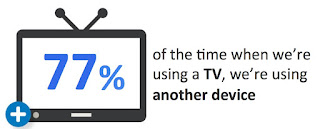But for some time now, the first screen gets some competition: notebooks, tablets, smartphones, all these cool devices have invaded the living room.
Let's have a closer look of what is called Social TV.
Majority of our daily media interactions are screen based
Our time online is spread between 4 primary media devices
TV is still the screen the majority of us are using the most during our leisure time. The big surprise is the way we watch TV in 2013.
77% use another device while they watch TV
Obviously viewers' attention is decreasing from the big screen.
What do the viewers do on their other devices while they watch TV?
This is where Social TV comes. Social TV refers to technologies surrounding television that promote communication and social interaction related to program content. It's hard to tell how many of these 77% described above are interacting with what they're watching but it's on this dimension that brands and broadcasters start to actively work on. 2013 will be a huge year for Social TV.
Social TV ecosystem
I've identified 4 main groups of actors in the Social TV space.The first group is composed of companies like Twitter whose services have been diverted from their initial usage but, because they are simple and easy, reliable and mainstream, work pretty well to share emotions when watching TV.
Then we have dedicated startups like Viggle, GetGlue or Zeebox that want to impose their supremacy to users by developing their own brand, proposing a richer second screen experience on top of the TV layer (discussions, interactions, etc.)
Afterwards, there are the brands, torn between selling their soul to these startups or creating their own second screen solutions.
Finally, there are the broadcasters, trying to protect their business by managing the entire viewer experience from A to Z, and attempting to stop the bleeding of advertising revenue that switches slowly towards the online side. (Online advertising is projected to overtake TV advertising by 2016.)
What can Social TV bring to users, brands and broadcasters
Depending on which side you are, you are not expecting the same from Social TV. If you are a viewer, you may want a richer experience like additional informations pushed to you in real-time when you watch a drama, a predictive game or trivia to play with friends along the actions of a football game, an opportunity to buy the products you see, or a way to express your opinion during a political debate.If you are a brand, it's a fantastic opportunity to interact directly with your customers and get more informations on their behavior. It's a new way to advertise without being interruptive. It's a perfect solution to measure instantly the results of an operation and get accurate KPIs.
If you are a broadcaster, you can get a slice of the online advertisement pie and improve your service to users by proposing experiences that you are the only one able to propose (remember, you are the guy that controls the stream on the first screen...).
Conclusion
We've been studying the social TV business and opportunities for more than 2 years now with my buddy Carlos Diaz & the Kwarter team and we think it makes sense to develop a comprehensive Social TV platform that simplifies the development of second screen experiences. At the end of the day, everybody, from the brands and their agencies to the broadcasters and the end users will be satisfied. We've raised $4M in venture capital last month to achieve this goal.Update: Last NFL football game, halftime show, commercials and power outage combined to make it the most social event on television to date. The Super Bowl tallied up 30.6M social media comments (Twitter, public Facebook data and GetGlue checkins), 2.5 times last year’s social activity of 12.2 million.





I'm extremely impressed along with your writing talents as well as with the structure to your weblog. Is that this a paid subject or did you customize it your self? Anyway keep up the excellent high quality writing, it is rare to look a great blog like this one nowadays..
ReplyDeleteLook at my webpage - wordpress